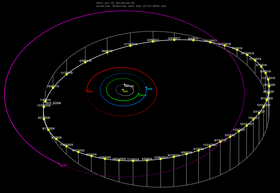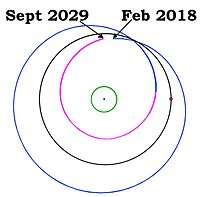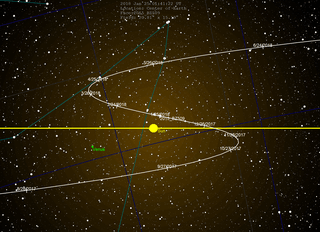514107 Kaʻepaokaʻawela
514107 Kaʻepaokaʻawela /kəˌɛpə.oʊkə.ɑːˈvɛlə/, provisional designation 2015 BZ509 and nicknamed Bee-Zed,[9] is a small asteroid, approximately 3 kilometers (2 miles) in diameter,[8] in a resonant, co-orbital motion with Jupiter.[3] Its orbit is retrograde, which is opposite to the direction of most other bodies in the Solar System.[4] It was discovered on 26 November 2014, by astronomers of the Pan-STARRS survey at Haleakala Observatory on the island of Maui, United States.[1] The unusual object is the first example of an asteroid in a 1:–1 resonance with any of the planets.[5] A study has suggested it may be an interstellar asteroid captured 4.5 billion years ago into an orbit around the Sun.
 Retrograde orbit of 2015 BZ509 with 100 day motion markers | |
| Discovery [1] | |
|---|---|
| Discovered by | Pan-STARRS 1 |
| Discovery site | Haleakala Obs. |
| Discovery date | 26 November 2014 |
| Designations | |
| (514107) 2015 BZ509 | |
| Pronunciation | /kəˌɛpə.oʊkə.ɑːˈvɛlə/[2] |
Named after | Kaʻepaokaʻāwela |
| 2015 BZ509 Bee-Zed (nickname) | |
| retrograde Jupiter co-orbital [3][4][5] asteroid [6] · unusual [7] | |
| Orbital characteristics [6] | |
| Epoch 27 April 2019 (JD 2458600.5) | |
| Uncertainty parameter 2 | |
| Observation arc | 2.81 yr (1,026 d) |
| Aphelion | 7.0899 AU |
| Perihelion | 3.1889 AU |
| 5.1394 AU | |
| Eccentricity | 0.3795 |
| 11.65 yr (4,256 d) | |
| 100.26° | |
| 0° 5m 4.56s / day | |
| Inclination | 163.02° |
| 307.42° | |
| 257.48° | |
| Jupiter MOID | 0.2252 AU |
| TJupiter | -0.7460 |
| Physical characteristics | |
Mean diameter | 3 km (approx.)[8] |
| 16.0[6] | |
Nomenclature
The Hawaiian name Kaʻepaokaʻāwela [kəˌʔɛpəˌokəʔaːˈvɛlə] is composed of ka 'the', ʻepa 'tricky' or 'mischievous', referring to its contrary orbit, o 'of', and Kaʻāwela 'Jupiter'.[2][10] The name was created by A Hua He Inoa, a Hawaiian-language program dedicated to naming objects discovered with Pan-STARRS.[11] The A Hua He Inoa program consists of Hawaiian language experts and astronomers at the ʻImiloa Astronomy Center of Hawaii.[6][11] Their submitted name was approved by the International Astronomical Union on 9 April 2019.[6] Prior to the naming of Kaʻepaokaʻawela, it was given the provisional designation 2015 BZ509 during 16–31 January 2015, for being the 12,750th object first observed in that period.[1][12] It was then numbered 514107 and added to the minor planet catalog by the Minor Planet Center on 2 March 2018 (M.P.C. 109159),[13] after its orbit became sufficiently determined.[1]
Orbit


Kaʻepaokaʻawela orbits the Sun at a distance of 3.2–7.1 AU once every 11 years and 8 months (4,256 days; semi-major axis of 5.14 AU). Its orbit has an eccentricity of 0.38 and an inclination of 163° with respect to the ecliptic.[6]
Its period is close to the 11.86-year period of Jupiter. During one Jovian year, Jupiter moves 360° around the sun whereas Kaʻepaokaʻawela moves 366.3° in the opposite direction. The eccentricity of its orbit allows it to alternately pass inside and outside of Jupiter's orbit at its closest approaches of 176 million kilometers. Each time it passes near Jupiter its orbital elements, including its period, are slightly altered. Over thousands of years the angle between the position of the asteroid and its perihelion minus the angle between Jupiter and the asteroid's perihelion tends to oscillate around zero with a period of about 660 years and an amplitude of about 125°, although sometimes this difference slips by a whole 360°.[note 1]
The adjunct diagram shows one complete orbit of asteroid Kaʻepaokaʻawela in a frame of reference rotating with Jupiter. The view is from the north looking south onto the Solar System. The dot in the middle is the Sun and the green circle is the orbit of Earth. The black circle shows the size of the orbit of Jupiter but in this frame of reference Jupiter (the red dot) stays almost stationary at the point on the circle directly to the right of the sun. The orbit of this asteroid is shown in blue when it is above the plane of the orbit of Jupiter, and in magenta when it is below the plane of the orbit of Jupiter.[3]
The second diagram shows one complete orbit of asteroid Kaʻepaokaʻawela in a frame of reference rotating with Jupiter. The view is from the side looking into the Solar System. The Sun is the yellow disk in the middle. The plane of the orbit of Jupiter is shown in black, but in this frame of reference Jupiter (the red dot) stays at the right end of the black line. The orbit of this asteroid is shown in blue when it is above (north of) the plane of the orbit of Jupiter, and it is shown in magenta when it is below (south of) the plane of the orbit of Jupiter.[3]
Perturbations from Jupiter maintain the stability of this orbit over millions of years. Simulations show that it has been in its co-orbital relation with Jupiter for at least a million years and will continue for at least another million years. It is somewhat of a mystery how this asteroid (or comet) got into this orbit, but it is thought that at some time in the distant past it was put into an orbit resembling its present orbit by an interaction with Saturn, and then its orbit was perturbed into the state it is in today.[3] Likewise, in the far future it may eventually get close enough to Saturn to be expelled from its present co-orbital relation with Jupiter.

Possible interstellar origin
A statistical search for stable orbits by Fathi Namouni and Helena Morais using one million objects with similar orbits to that of Kaʻepaokaʻawela identified 27 that were stable for 4.5 billion years, the lifetime of the Solar System. Using this result they concluded that Kaʻepaokaʻawela has been in its retrograde resonance with Jupiter since the origin of the Solar System instead of it being an object that is only briefly in this orbit that was observed by chance using the Copernican principle.[14][15] Since its retrograde orbit is in the opposite direction as objects that formed in the early Solar System they posit that Kaʻepaokaʻawela has an interstellar origin.[16] If confirmed, this origin would have implications on current theories such as the detailed timing and mechanics of planet formation, and the delivery of water and organic molecules to Earth.[14]
Others suggest that Kaʻepaokaʻawela originated in the Oort cloud or that it acquired a retrograde orbit due to interactions with Planet Nine, and that it is a short term resident of its current resonance.[14] Given the small fraction of object with orbits like Kaʻepaokaʻawela that survive for the life of the Solar System, they find that the original population must have been an implausible ten times as large as the current asteroid belt.[17]
See also
- List of exceptional asteroids § Retrograde
- 'Oumuamua, an interstellar object
Notes
- See Figure 2 of Wiegert, Connors & Veillet 2017.
References
- "(514107) Ka'epaoka'awela = 2015 BZ509". Minor Planet Center. Retrieved 7 March 2018.
- Wiegert, Paul; Connors, Martin; Veillet, Christian (March 2017). "A retrograde co-orbital asteroid of Jupiter". Nature. 543 (7647): 687–689. Bibcode:2017Natur.543..687W. doi:10.1038/nature22029. PMID 28358083.CS1 maint: ref=harv (link)
- Plait, Phil (30 March 2017). "Meet Jupiter's backwards little friend: Asteroid 2015 BZ509". SyFy Wire. Retrieved 30 March 2017.
- Wiegert, Paul (30 March 2017). "The first retrograde co-orbital asteroid: 2015 BZ509 – a Trojan in retreat". University of Western Ontario. Retrieved 7 March 2018.
- "JPL Small-Body Database Browser: 514107 Ka'epaoka'awela (2015 BZ509)" (2017-09-17 last obs.). Jet Propulsion Laboratory. Retrieved 3 December 2018.
- "List Of Other Unusual Objects". Minor Planet Center. Retrieved 15 November 2018.
- "Discovery of the first body in the Solar System with an extrasolar origin". www2.cnrs.fr (Press release). CNRS. 22 May 2018. Retrieved 31 May 2018.
- "The stable retrograde orbit of the Bee-Zed asteroid explained". Phys.org. 28 June 2017.
- ulukau HAWAIIAN ELECTRONIC LIBRARY
- Callis, Tom (30 January 2019). "Astronomers giving more Hawaiian names". The Garden Island. Retrieved 13 May 2019.
- "New- And Old-Style Minor Planet Designations". Minor Planet Center. Retrieved 13 May 2019.
- "MPC/MPO/MPS Archive". Minor Planet Center. Retrieved 7 March 2018.
- Billings, Lee (21 May 2018). "Astronomers Spot Potential "Interstellar" Asteroid Orbiting Backward around the Sun". Scientific American. Retrieved 1 June 2018.
- Namouni, Fathi; Morais, Maria Helena Moreira (21 May 2018). "An interstellar origin for Jupiter's retrograde co-orbital asteroid". Monthly Notices of the Royal Astronomical Society: Letters. 477 (1): L117–L121. arXiv:1805.09013. Bibcode:2018MNRAS.477L.117N. doi:10.1093/mnrasl/sly057. ISSN 1745-3925.
- Halton, Mary (21 May 2018). "'Permanent' interstellar visitor found". BBC News. Retrieved 1 June 2018.
- Morbidelli, A.; Batygin, K.; Brasser, R.; Raymond, S. (2020). "No evidence for interstellar planetesimals trapped in the Solar System". arXiv:2006.04534.
External links
| Wikimedia Commons has media related to (514107) 2015 BZ509. |
- The first retrograde co-orbital asteroid: 2015 BZ509 on YouTube, Scientias.nl (0:52 min)
- Asteroid Lightcurve Database (LCDB), query form (info)
- Discovery Circumstances: Numbered Minor Planets (510001)-(515000) – Minor Planet Center
- Backwards asteroid shares an orbit with Jupiter without crashing 29 March 2017
- Is There An Alien Asteroid Among Us? Bob King, 23 May 2018
- Animation of orbital motion at APOD (30 May 2018)
- 514107 Kaʻepaokaʻawela at AstDyS-2, Asteroids—Dynamic Site
- 514107 Kaʻepaokaʻawela at the JPL Small-Body Database
